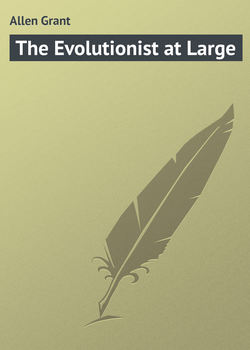The Evolutionist at Large

Реклама. ООО «ЛитРес», ИНН: 7719571260.
Оглавление
Allen Grant. The Evolutionist at Large
PREFACE
A BALLADE OF EVOLUTION
I. MICROSCOPIC BRAINS
II. A WAYSIDE BERRY
III. IN SUMMER FIELDS
IV. A SPRIG OF WATER CROWFOOT
V. SLUGS AND SNAILS
VI. A STUDY OF BONES
VII. BLUE MUD
VIII. CUCKOO-PINT
IX. BERRIES AND BERRIES
X. DISTANT RELATIONS
XI. AMONG THE HEATHER
XII. SPECKLED TROUT
XIII. DODDER AND BROOMRAPE
XIV. DOG'S MERCURY AND PLANTAIN
XV. BUTTERFLY PSYCHOLOGY
XVI. BUTTERFLY ÆSTHETICS
XVII. THE ORIGIN OF WALNUTS
XVIII. A PRETTY LAND-SHELL
XIX. DOGS AND MASTERS
XX. BLACKCOCK
XXI. BINDWEED
XXII. ON CORNISH CLIFFS
Отрывок из книги
These Essays originally appeared in the columns of the 'St. James's Gazette,' and I have to thank the courtesy of the Editor for kind permission to republish them. My object in writing them was to make the general principles and methods of evolutionists a little more familiar to unscientific readers. Biologists usually deal with those underlying points of structure which are most really important, and on which all technical discussion must necessarily be based. But ordinary people care little for such minute anatomical and physiological details. They cannot be expected to interest themselves in the flexor pollicis longus, or the hippocampus major about whose very existence they are ignorant, and whose names suggest to them nothing but unpleasant ideas. What they want to find out is how the outward and visible forms of plants and animals were produced. They would much rather learn why birds have feathers than why they have a keeled sternum; and they think the origin of bright flowers far more attractive than the origin of monocotyledonous seeds or exogenous stems. It is with these surface questions of obvious outward appearance that I have attempted to deal in this little series. My plan is to take a simple and well-known natural object, and give such an explanation as evolutionary principles afford of its most striking external features. A strawberry, a snail-shell, a tadpole, a bird, a wayside flower – these are the sort of things which I have tried to explain. If I have not gone very deep, I hope at least that I have suggested in simple language the right way to go to work.
I must make an apology for the form in which the essays are cast, so far as regards the apparent egotism of the first person. When they appeared anonymously in the columns of a daily paper, this air of personality was not so obtrusive: now that they reappear under my own name, I fear it may prove somewhat too marked. Nevertheless, to cut out the personal pronoun would be to destroy the whole machinery of the work: so I have reluctantly decided to retain it, only begging the reader to bear in mind that the I of the essays is not a real personage, but the singular number of the editorial we.
.....
I have to thank the kindness of my friend the Rev. E. Purcell, of Lincoln College, Oxford, for the clever and appropriate design which appears upon the cover.
My dog Grip, running about on the path there, with his nose to the ground, and sniffing at every stick and stone he meets on his way, gives us the clue to solve the problem. Grip, as Professor Croom Robertson suggests, seems capable of extracting a separate and distinguishable smell from everything. I have only to shy a stone on the beach among a thousand other stones, and my dog, like a well-bred retriever as he is, selects and brings back to me that individual stone from all the stones around, by exercise of his nose alone. It is plain that Grip's world is not merely a world of sights, but a world of smells as well. He not only smells smells, but he remembers smells, he thinks smells, he even dreams smells, as you may see by his sniffing and growling in his sleep. Now, if I were to cut open Grip's head (which heaven forfend), I should find in it a correspondingly big smell-nerve and smell-centre – an olfactory lobe, as the anatomists say. All the accumulated nasal experiences of his ancestors have made that lobe enormously developed. But in a man's head you would find a very large and fine optic centre, and only a mere shrivelled relic to represent the olfactory lobes. You and I and our ancestors have had but little occasion for sniffing and scenting; our sight and our touch have done duty as chief intelligencers from the outer world; and the nerves of smell, with their connected centres, have withered away to the degenerate condition in which they now are. Consequently, smell plays but a small part in our thought and our memories. The world that we know is chiefly a world of sights and touches. But in the brain of dog, or deer, or antelope, smell is a prevailing faculty; it colours all their ideas, and it has innumerable nervous connections with every part of their brain. The big olfactory lobes are in direct communication with a thousand other nerves; odours rouse trains of thought or powerful emotions in their minds just as visible objects do in our own.
.....